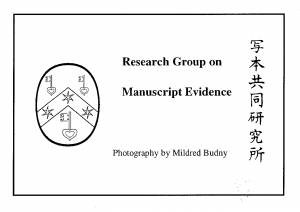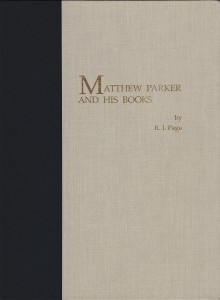1993 Congress
January 1, 2014 in Book, Conference Announcement, Exhibition, ICMS, International Congress on Medieval Studies, Manuscript Studies, Photographic Exhibition
28th International Congress on Medieval Studies
6‒9 May, 1993
[First published on our first website on *19 April 2006, with updates]
 At the 1993 Congress, for the first time, the Research Group on Manuscript Evidence appeared officially on the program, as it sponsored one Session and provided a Photographic Exhibition. A report of its contributions was offered in another session as well, with a publication of its text and some illustrations.
At the 1993 Congress, for the first time, the Research Group on Manuscript Evidence appeared officially on the program, as it sponsored one Session and provided a Photographic Exhibition. A report of its contributions was offered in another session as well, with a publication of its text and some illustrations.
At some earlier Congresses, at first Mildred Budny (1985–1987 and 1989–1992) and, then, also Timothy Graham (1992) presented papers. The Abstracts of some of those papers are reported in the Old English Newsletter.
This Congress marked the first year of our sponsored Sessions at the International Congress on Medieval Studies held by the Medieval Institute of Western Michigan University. Various of our Associates also participated in this and other Sessions at the Congress.
The official Congress Archive of the Medieval Institute reproduces the individual Congress Program Booklets (plus their “Corrigenda” as presented at the Congress). The 1993 Congress began a partly interrupted Series of Congresses at which the Research Group on Manuscript Evidence participated. Our own Congress Archive records the stages of this Series, plus its “Prequel” in earlier Congresses.

Medieval Institute, Walwood Hall, Western Michigan University, February 1992. Photography © Mildred Budny
I. Session sponsored by the Research Group on Manuscript Evidence
1. Insular, Anglo-Saxon, and Early Anglo-Norman Manuscript Art at Corpus Christi College, Cambridge
Organizer: Mildred Budny (Research Group on Manuscript Evidence ‒ Corpus Christi College, Cambridge)
Presider: Mildred Budny
Presenters:
- Leslie French (Research Group on Manuscript Evidence), “Arithmetic and Art: C.C.C.C. MS 352“
- Timothy Graham (Research Group on Manuscript Evidence), “Budny’s Illustrated Catalogue: Fruits and Seeds“
Panel Discussion:
- Mildred Budny
- James Carley (York University), and
- Robert Mathiesen (Brown University)
The Subject
The focus of this Session was a work still in progress. In time it emerged as a co-publication of Medieval Institute Publications and the Research Group on Manuscript Evidence.

 The Illustrated Catalogue of Insular, Anglo-Saxon, and Early Anglo-Norman Manuscript Art at Corpus Christi College, Cambridge (ISBN 1-879288-87-7) was published in two volumes in time for distribution at the 1997 Congress, when a series of Receptions and Book-Signings celebrated the “Cast & Crew” responsible for its collective achievement. Its components are celebrated here.
The Illustrated Catalogue of Insular, Anglo-Saxon, and Early Anglo-Norman Manuscript Art at Corpus Christi College, Cambridge (ISBN 1-879288-87-7) was published in two volumes in time for distribution at the 1997 Congress, when a series of Receptions and Book-Signings celebrated the “Cast & Crew” responsible for its collective achievement. Its components are celebrated here.
The publication is available through Medieval Institute Publications its Non-Series Volumes via https://secure.touchnet.net/C21782_ustores/web/product_detail.jsp?PRODUCTID=96&SINGLESTORE=true.
[Update: That link is no longer active. With a change in direction, Medieval Institute Publications has transferred the principal distribution to the Research Group on Manuscript Evidence. As the Research Group, mainly powered by volunteer work, has fewer overheads than a standard academic publisher, it is able to present the set at an attractive price. See our special Promotional Offer.]
Introduction to the Session
The Research Group Archives for the 1993 Congress possess a single-page, double-spaced printout of the text of Mildred Budny’s Introduction to this Session sponsored by the Research Group on Manuscript Evidence — the first of its Sessions sponsored at the Annual Congress. With the abbreviated heading “RGME AZO session 93: MOB INTRO”, the text presents the plan, scope, and sequence:
The title of this session, “Insular, Anglo-Saxon, and Early Anglo-Norman Manuscript Art at Corpus Christi College, Cambridge,” is also the title of a catalogue to be published soon by Medieval Institute Publications in association with the Research Group on Manuscript Evidence, currently based at Corpus Christi College. The catalogue covers all fifty-six manuscripts of fragments containing illustration and decoration made in the British Isles to circa 1100. This includes not only manuscripts made there but also manuscripts imported during the early medieval period, to which such elements were added. The range extends from the sixth-century Italian Gospels of St. Augustine of Canterbury; through the magnificent illustrated Corpus Prudentius; to a masterpiece made by the Welsh scribal Artist Ieuan ap Sulien between 1085 and 1091.
The catalogue reflects the character of the collection and of the Research Group, which is devoted to an integrated approach to manuscript studies, by examining manuscripts as whole objects, archaeological artefacts, carries of text, works of art, and monuments of culture. The catalogue entries provide an account of the manuscript, followed by a detailed inventory of its art and ornament; the plates illustrate very many of those elements. The approach aims to address the interests and concerns of a wide range of fields. For example, in the inventory the identified locations of initials or other elements offer art historians a guid to the position which the decoration occupies within the book, while the descriptions give textual scholars an indication of which portions of the book received decoration, of which styles, of what dates, and by which hands, original or added, so as to assist assessments of its particular copy of the text. The survey of the layout, script, and art may cast light on the grade of book, its purposes, and its intended audience. The plates provide new reproductions of many features, by showing whole pages and series of pages with text, script, decoration, illustration, and artists’ sketches. The catalogue aims to bring the manuscripts to wider attention and make them more accessible to research, which can revise or refine its results.
First Leslie French will discuss a single example of a manuscript in the catalogue, one which he has been studying in depth for some time and to whose entry he contributed. Then Tim Graham, who greatly helped with the catalogue, will survey some discoveries which emerged from this work. Afterwards James Carley, Bob Mathiesen, and I will consider the nature and challenges of cataloguing, using this catalogue as a case in point.
By inference, this Session “Introduction” cites Corpus Christi College MSS 23A, 199, 286, 352. In the published Catalogue, these manuscripts have respectively Budny Numbers 1, 24, 55, and 20. ]
II. Photographic Exhibition
“The Integrated Approach to Manuscript Studies”
 The Research Group on Manuscript Evidence provided a Photographic Exhibition, “The Integrated Approach to Manuscript Studies“, to accompany events at the Congress. Descriptions of this exhibition and the series of exhibitions to which it belongs, appear in our Publications and Photographic Exhibitions & Masterclasses. A further variation of this exhibition was presented at the 1994 Congress.
The Research Group on Manuscript Evidence provided a Photographic Exhibition, “The Integrated Approach to Manuscript Studies“, to accompany events at the Congress. Descriptions of this exhibition and the series of exhibitions to which it belongs, appear in our Publications and Photographic Exhibitions & Masterclasses. A further variation of this exhibition was presented at the 1994 Congress.
Precursors of the exhibition appeared at events in the Research Group’s earlier series of Seminars on “The Evidence of Manuscripts”, starting with the first of the Seminars in the Series which took place at Oxford: Research on Anglo-Saxon Manuscripts in Cambridge and Oxford” (20 June 1992).
III. Report on Contributions by
the Research Group on Manuscript Evidence
to the “CORPUS Project”
 Also, as part of the Session on
Also, as part of the Session on
“Insular and Anglo-Saxon Illuminated Manuscripts, I: Past, Present, and Future”,
co-organized by Thomas H. Ohlgren and Mildred Budny,
to report and to assess the on-going “Corpus Project” recording the Corpus of Insular and Anglo-Saxon Illuminated Manuscripts (CORPUS)
— which updates and augments Thomas H. Ohlgren’s collaborative
Iconographic Catalogue of Insular and Anglo-Saxon Illuminated Manuscripts (1986) —
Mildred Budny presented a paper on “Contributions by the Research Group on Manuscript Evidence”.
This paper was published in the Old English Newsletter, now online as Old English Newsletter, 26:3, A-8–A-23,
with photographs by Mildred Budny,
reproduced by permission of the Master and Fellows of Corpus Christi College, Cambridge, and Mildred Budny.
The Abstracts of both this paper and other papers in that Session, by our Associates and others, appear in the Old English Newsletter, 26:1 (Spring 1993), A-24–A-26, now online as Old English Newsletter, 26:3.
*****
IV. Co-Publications Commence
Matthew Parker and His Books (1993)
 This year, the on-going collaboration between the Research Group on Manuscript Evidence and Medieval Institute Publications at Western Michigan University saw the co-publication of our first illustrated volume.
This year, the on-going collaboration between the Research Group on Manuscript Evidence and Medieval Institute Publications at Western Michigan University saw the co-publication of our first illustrated volume.
R.I. Page,
Matthew Parker and His Books:
Sandars Lectures in Bibliography
Delivered on 14, 16, and 18 May 1990
at the University of Cambridge,
[with] photographs by Mildred Budny
Medieval Institute Publications
in association with
The Research Group on Manuscript Evidence,
The Parker Library
Corpus Christi College, Cambridge
(Kalamazoo, Michigan, 1993)
*****
The full 1993 Congress program is archived: 28th International Congress on Medieval Studies.
*****
After Life
In 1994, the Research Group again appeared at the Congress, with 2 Sessions, a Photographic Exhibition, and other activities (1994 Congress). In 1995, the Research Group again sponsored a Session (1995 Congress). Then, with disruptions to that momentum, the Research Group concentrated upon completing the work of revising, typesetting, indexing, and printing camera-ready pages for the publication of the Illustrated Catalogue, which its printers delivered to the Medieval Institute in April 1997, shortly before the Annual Congress, at which the Research Group held a set of Cast & Crew Parties (1997 Congress), to celebrate the collective accomplishment. Another gap, while the Research Group concentrated upon other activities and Events elsewhere, intervened before its return to sponsor Sessions in 2004 — a tradition which we have continued and expanded, with the addition also (since 2006) of Co-Sponsored Sessions and (since our Anniversary Year of 2014) of Co-Sponsored Receptions.
The full course of the Research Group’s participation at the annual Congress is surveyed as our Congress Activities.
Among our other Events, the 2003 Colloquium (at The Ohio State University) on “Innovations for Editing Texts” included a joint presentation by Thomas H. Ohlgren and Mildred Budny about “The Once and Future CORPUS Project”. It provided updates for the subject of Thomas Ohlgren’s session at the 1993 Congress.
*****










